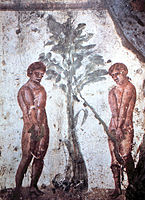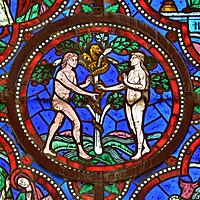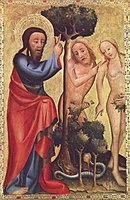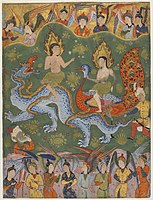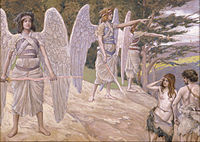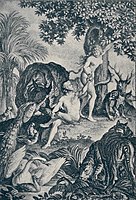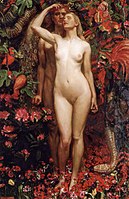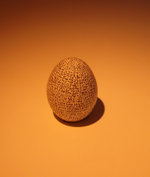Adam and Eve
Adam and Eve, according to the creation myth[Note 1] of the Abrahamic religions,[1][2] were the first man and woman. They are central to the belief that humanity is in essence a single family, with everyone descended from a single pair of original ancestors.[3] They also provide the basis for the doctrines of the fall of man and original sin, which are important beliefs in Christianity, although not held in Judaism or Islam.[4]
In the
Neither Adam nor Eve is mentioned elsewhere in the Hebrew scriptures apart from a single listing of Adam in a genealogy in 1 Chronicles 1:1,[5] suggesting that although their story came to be prefixed to the Jewish story, it has little in common with it.[6] The myth underwent extensive elaboration in later Abrahamic traditions, and it has been extensively analyzed by modern biblical scholars. Interpretations and beliefs regarding Adam and Eve and the story revolving around them vary across religions and sects; for example, the Islamic version of the story holds that Adam and Eve were equally responsible for their sins of hubris, instead of Eve being the first one to be unfaithful. The story of Adam and Eve is often depicted in art, and it has had an important influence in literature and poetry.
Hebrew Bible narrative
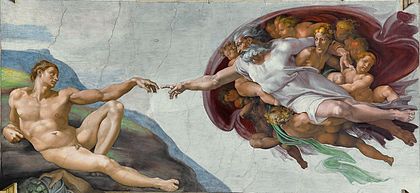
The opening chapters of the Book of Genesis provide a mythic history of the infiltration of evil into the world.[7] God places the first man and woman (Adam and Eve) in his Garden of Eden, whence they are expelled; the first murder follows, and God's decision to destroy the world and save only the righteous Noah and his sons; a new humanity then descends from these and spreads throughout the world, but although the new world is as sinful as the old, God has resolved never again to destroy the world by flood, and the History ends with Terah, the father of Abraham, from whom will descend God's chosen people, the Israelites.[8]
Creation narrative
Adam and Eve are the Bible's first man and first woman.[9][10] Adam's name appears first in Genesis 1 with a collective sense, as "mankind"; subsequently in Genesis 2–3 it carries the definite article ha, equivalent to English 'the', indicating that this is "the man".[9] In these chapters God fashions "the man" (ha adam) from earth (adamah), breathes life into his nostrils, and makes him a caretaker over creation.[9] God next creates for the man an ezer kenegdo, a "helper corresponding to him", from his side or rib.[10] The word 'rib' is a pun in Sumerian, as the word ti means both 'rib' and 'life'.[11][12] She is called ishsha, "woman", because, the text says, she is formed from ish, "man".[10] The man receives her with joy, and the reader is told that from this moment a man will leave his parents to "cling" to a woman, the two becoming one flesh.[10]
The Fall

The first man and woman are in God's Garden of Eden, where all creation is vegetarian and there is no violence. They are permitted to eat the fruits of all the trees except one, the tree of the knowledge of good and evil. The woman is tempted by a talking serpent to eat the forbidden fruit, and gives some to the man, who eats also.[10] (Contrary to popular myth she does not beguile the man, who appears to have been present at the encounter with the serpent).[10] God curses all three, the man to a lifetime of hard labour followed by death, the woman to the pain of childbirth and to subordination to her husband, and the serpent to go on his belly and suffer the enmity of both man and woman.[10] God then clothes the nakedness of the man and woman, who have become god-like in knowing good and evil, then banishes them from the garden lest they eat the fruit of a second tree, the tree of life, and live forever.[13]
Expulsion from Eden
The story continues in Genesis 3 with the "expulsion from Eden" narrative. A
The expulsion from Eden narrative begins with a dialogue between the woman and a serpent,[15] identified in Genesis 3:1[16] as an animal that was more crafty than any other animal made by God, although Genesis does not identify the serpent with Satan.[17] The woman is willing to talk to the serpent and respond to the creature's cynicism by repeating God's prohibition against eating fruit from the tree of knowledge (Genesis 2:17).[18][19] The woman is lured into dialogue on the serpent's terms which directly disputes God's command.[20] The serpent assures the woman that God will not let her die if she ate the fruit, and, furthermore, that if she ate the fruit, her "eyes would be opened" and she would "be like God, knowing good and evil" (Genesis 3:5).[21] The woman sees that the fruit of the tree of knowledge is a delight to the eye and that it would be desirable to acquire wisdom by eating the fruit. The woman eats the fruit and gives some to the man (Genesis 3:6).[22] With this the man and woman recognize their own nakedness, and they make loincloths of fig leaves (Genesis 3:7).[23][24]
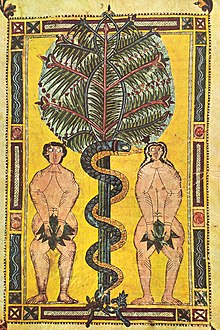
In the next narrative dialogue, God questions the man and the woman (Genesis 3:8–13),[25][15] and God initiates a dialogue by calling out to the man with a rhetorical question designed to consider his wrongdoing. The man explains that he hid in the garden out of fear because he realized his own nakedness (Genesis 3:10).[26][27] This is followed by two more rhetorical questions designed to show awareness of a defiance of God's command. The man then points to the woman as the real offender, and he implies that God is responsible for the tragedy because the woman was given to him by God (Genesis 3:12).[28][29] God challenges the woman to explain herself, and she shifts the blame to the serpent (Genesis 3:13).[30][31]
Divine pronouncement of three judgments is then laid against all the culprits (Genesis 3:14–19).
The chiasmus structure of the death oracle given to Adam in Genesis 3:19[38] is a link between man's creation from "dust" (Genesis 2:7)[39] to the "return" of his beginnings:[40] "you return, to the ground, since from it you were taken, for dust you are, and to dust, you will return."
The garden account ends with an intradivine monologue, determining the couple's expulsion, and the execution of that deliberation (Genesis 3:22–24).[41][15] The reason given for the expulsion was to prevent the man from eating from the tree of life and becoming immortal: "Behold, the man is become as one of us, to know good and evil; and now, lest he put forth his hand, and take also of the tree of life, and eat, and live for ever" (Genesis 3:22).[42][17]: 18 [43] God exiles Adam and Eve from the Garden and installs cherubs (supernatural beings that provide protection) and the "ever-turning sword" to guard the entrance (Genesis 3:24).[44][45]
Offspring
Genesis 4 narrates life outside the garden, including the birth of Adam and Eve's first children
Textual history
The Primeval History forms the opening chapters of the
Abrahamic traditions
Judaism
It was also recognized in
According to traditional Jewish belief, Adam and Eve are buried in the
In Genesis 2:7 "God breathes into the man's nostrils and he becomes nefesh hayya", signifying something like the English word "being", in the sense of a corporeal body capable of life; the concept of a "soul" in the modern sense, did not exist in Hebrew thought until around the 2nd century BC, when the idea of a bodily resurrection gained popularity.[56]
Christianity
Some early
Medieval Christian art often depicted the Edenic Serpent as a woman (often identified as
Based on the Christian doctrine of the
Over the centuries, a system of unique Christian beliefs had developed from these doctrines. Baptism became understood as a washing away of the stain of hereditary sin in many churches, although its original symbolism was apparently rebirth. Additionally, the serpent that tempted Eve was interpreted to have been Satan, or that Satan was using a serpent as a mouthpiece, although there is no mention of this identification in the Torah and it is not held in Judaism.
As well as developing the theology of the protoplasts, the medieval Church also expanded the historical narrative in a vast tradition of Adam books, which add detail to the fall, and tell of their life after the expulsion from Eden. These are continued in the Legend of the Rood, dealing with Seth's return to Paradise and subsequent events involving the wood from the tree of life. These stories were widely believed in Europe until early modern times.
Regarding the real existence of the progenitors – as of other narratives contained in Genesis – the Catholic Church teaches that Adam and Eve were historical humans, personally responsible for the original sin. This position was clarified by Pope Pius XII in the encyclical Humani Generis, in which the Pope condemned the theory of polygenism and expressed that original sin comes "from a sin actually committed by an individual Adam". Despite this, the Humani Generis also states that the belief in evolution is not in contrast to Catholic doctrine; this has led to a gradual acceptance of theistic evolution among Roman Catholic and Independent Catholic theologians, a position that has been encouraged by Pope John Paul II, Pope Benedict XVI and Pope Francis.[59][60][61][62]
The biblical fall of Adam and Eve is also understood by some Christians (especially those in the
Gnostic traditions
Gnostics discussed Adam and Eve in two known surviving texts, namely the "Apocalypse of Adam" found in the Nag Hammadi documents and the Testament of Adam. The creation of Adam as Protoanthropos, the original man, is the focal concept of these writings.
Another Gnostic tradition held that Adam and Eve were created to help defeat Satan. The serpent, instead of being identified with Satan, is seen as a hero by the Ophites. Still other Gnostics believed that Satan's fall, however, came after the creation of humanity. As in Islamic tradition, this story says that Satan refused to bow to Adam due to pride. Satan said that Adam was inferior to him as he was made of fire, whereas Adam was made of clay. This refusal led to the fall of Satan recorded in works such as the Book of Enoch.
In Mandaeism, "(God) created all the worlds, formed the soul through his power, and placed it by means of angels into the human body. So He created Adam and Eve, the first man and woman."[68]
Islam

In
In
The concept of "original sin" does not exist in
In Swahili literature, Eve ate from the forbidden tree, thus causing her expulsion, after being tempted by Iblis. Thereupon, Adam heroically eats the forbidden fruit in order to follow Eve and protect her on earth.[76]
Baháʼí Faith
In the
Historicity
While a traditional view attributes the Book of Genesis to Mosaic authorship, modern scholars consider the Genesis creation narrative as one of various ancient origin myths.[83][84]
Analysis like the documentary hypothesis also suggests that the text is a result of the compilation of multiple previous traditions, explaining apparent contradictions.[85][86] Other stories of the same canonical book, like the Genesis flood narrative, are also understood as having been influenced by older literature, with parallels in the older Epic of Gilgamesh.[87]
Y chromosomal Adam and Mitochondrial Eve
Scientific developments within the natural sciences have shown evidence that humans, and all other living and extinct species, share a common ancestor and evolved through natural processes, over billions of years to diversify into the life forms we know today.[88][89][relevant?]
In
Arts and literature
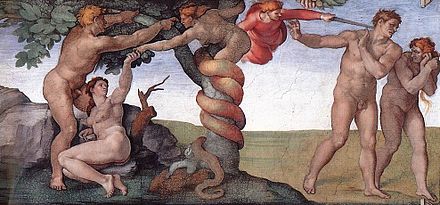
Mark Twain wrote humorous and satirical diaries for Adam and Eve in both "Eve's Diary" (1906) and The Private Life of Adam and Eve (1931), posthumously published.
In
In Ray Nelson's novel Blake's Progress the poet William Blake and his wife Kate travel to the end of time where the demonic Urizen offers them his own re-interpretation of the Biblical story: "In this painting you see Adam and Eve listening to the wisdom of their good friend and adviser, the serpent. One might even say he was their Savior. He gave them freedom, and he would have given them eternal life if he'd been allowed to."[citation needed]
In
Image gallery
-
Early Christian depiction of Adam and Eve in the Catacombs of Marcellinus and Peter
-
Detail of a stained glass window (12th century) in Saint-Julien cathedral - Le Mans, France
-
Depiction of the Fall inKunsthalle Hamburg, by Master Bertram, 1375-1383
-
Adam and Eve, engraving by Albrecht Dürer, 1504 (National Gallery of Art)
-
Adam and Eve by Albrecht Dürer, 1507
-
Adam and Eve in paradise (The Fall), Eve gives Adam the forbidden fruit, by Lucas Cranach the Elder, 1533
-
Adam and Eve from a copy of the Falnama (Book of Omens) ascribed to Ja'far al-Sadiq, c. 1550, Safavid dynasty, Iran
-
Adam and Eve by Titian, c. 1550
-
Adam and Eve by Maarten van Heemskerck, 1550
-
Adam and Eve Driven From Paradise by James Tissot, c. 1896-1902
-
Adam and Eve depicted in a mural in Abreha wa Atsbeha Church, Ethiopia
-
1896 illustration of Eve handing Adam the forbidden fruit
-
Adam and Eve by Frank Eugene, taken 1898, published in Camera Work no. 30, 1910
-
The Woman, the Man, and the Serpent by Byam Shaw, 1911
-
Adam and Eve byFranz Stuck, 1920
See also
Notes
- ^ Myth in this case not meaning a false story, but rather a traditional story which embodies a belief regarding some fact or phenomenon of experience, and in which often the forces of nature and of the soul are personified; a sacred narrative regarding a god, a hero, the origin of the world or of a people, etc.
- ^ See John Van Seters, Prologue to History: The Yahwist as Historian in Genesis Archived 2022-11-02 at the Wayback Machine (1992), pp.80, 155–156.
References
- ISBN 978-0759103221. Retrieved 16 August 2013.
Creation myths are symbolic stories describing how the universe and its inhabitants came to be. Creation myths develop through oral traditions and therefore typically have multiple versions.
- ^ Leeming, David (2010). Creation Myths of the World: Parts I-II. p. 303.
- ISBN 978-1-845-19395-9.
- ISBN 978-0-824-60305-2. Excerpt in Judaism's Rejection Of Original Sin Archived 2016-12-05 at the Wayback Machine.
- ^ Enns 2012, p. 84.
- ^ Blenkinsopp 2011, p. 3.
- ^ Blenkinsopp 2011, p. ix.
- ^ Blenkinsopp 2011, p. 1.
- ^ a b c Hearne 1990, p. 9.
- ^ a b c d e f g Galambush 2000, p. 436.
- ^ Kramer 1963, p. 149.
- ISBN 9780520203075. Retrieved 27 April 2019.
the strange story of Adam's 'spare rib' from which Eve was created (Genesis 2:20–3) makes perfect sense once it is realised that in Sumerian the feminine particle and the words for rib and life are all ti, so that the tale in its original form must have been based on Sumerian puns.
- ^ Alter 2004, p. 27–28.
- ISBN 9780931464195.)
{{cite book}}: CS1 maint: multiple names: authors list (link - ^ a b c d Mathews 1996, p. 226
- ^ Genesis 3:1
- ^ ISBN 9780195297515.
- ^ Genesis 2:17
- ^ Mathews 1996, p. 235
- ^ Mathews 1996, p. 236
- ^ Genesis 3:5
- ^ Genesis 3:6
- ^ Genesis 3:7
- ^ Mathews 1996, p. 237
- ^ Genesis 3:8–13
- ^ Genesis 3:10
- ^ Mathews 1996, p. 240
- ^ Genesis 3:12
- ^ Mathews 1996, p. 241
- ^ Genesis 3:13
- ^ Mathews 1996, p. 242
- ^ Genesis 3:14–19
- ^ Mathews 1996, p. 243
- ^ Mathews 1996, p. 248
- ^ Mathews 1996, p. 252
- ^ Genesis 3:20
- ^ Genesis 3:20
- ^ Genesis 3:19
- ^ Genesis 2:7
- ^ Mathews 1996, p. 253
- ^ Genesis 3:22–24
- ^ Genesis 3:22
- ^ Addis, Edward (1893). The Documents of the Hexateuch, Volume 1. Putnam. pp. 4–7.
- ^ Genesis 3:24
- ISBN 9781440192555.
- ^ Genesis 5:4
- ^ Betsy Halpern Amaru (1999). The Empowerment of Women in the Book of Jubilees, p. 17.
- ^ Enns 2012, p. 5.
- ^ Sailhamer 2010, p. 301 and fn.35.
- ^ a b Blenkinsopp 2011, p. 2.
- ^ Sailhamer 2010, p. 301.
- ^ Gmirkin 2006, p. 240-241.
- ^ Gmirkin 2006, p. 6.
- ^ Carr 2000, p. 492.
- ISBN 978-0195086799. Retrieved 27 December 2014.
The myth of Adam the Hermaphrodite grows out of three biblical verses
- ^ Harry Orlinsky's Notes to the NJPS Torah
- ^ "Tertullian, "De Cultu Feminarum", Book I Chapter I, Modesty in Apparel Becoming to Women in Memory of the Introduction of Sin Through a Woman (in "The Ante-Nicene Fathers")". Tertullian.org. Retrieved 2014-02-17.
- ISBN 9780141925752.
- ^ "Humani Generis (August 12, 1950) | PIUS XII". www.vatican.va. Retrieved 2020-11-17.
- ISSN 0140-0460.
- ^ John Paul II, Message to the Pontifical Academy of Sciences: On Evolution Archived 2021-12-08 at the Wayback Machine; the speech was made in French - for a dispute over whether the correct English translation of "la theorie de l'evolution plus qu'une hypothese" is "more than a hypothesis" or "more than one hypothesis", see Eugenie Scott, NCSE online version Archived 2018-10-02 at the Wayback Machine of Creationists and the Pope's Statement, which originally appeared in The Quarterly Review of Biology, 72.4, December 1997
- ^ McKenna, Josephine (2014-10-27). "Pope Francis: 'Evolution ... is not inconsistent with the notion of creation'". Religion News Service.
- ^ Hart, David Bentley (31 August 2022). "Sensus Plenior I: On gods and mortals". Leaves in the Wind. Retrieved 5 February 2023.
First Reader (Aug 31, 2022): Should we favor the 'atemporal fall' view then? David Bentley Hart (Aug 31, 2022): Well, I certainly do. But the original Eden story isn't about the 'fall' at all, except in the vague sense that it was a mythic aetiology of life's miseries. Second Reader (Sep 2, 2022): Can you briefly describe what you understand or hold the 'atemporal fall' to be? Hart (Sep 2, 2022): No, not briefly. Second Reader (Sep 2, 2022): An extended response would, of course, be satisfactory also! But no, if you are aware of any particularly good reflections on it, I'd be grateful for a reference. Hart (Sep 2, 2022): Bulgakov, The Bride of the Lamb
- ^ Behr, John (15 January 2018). "Origen and the Eschatological Creation of the Cosmos". Eclectic Orthodoxy. Archived from the original on 24 January 2023. Retrieved 5 February 2023.
Our beginning in this world and its time can only be thought of as a falling away from that eternal and heavenly reality, to which we are called.
- ^ Chenoweth, Mark (Summer 2022). "The Redemption of Evolution: Maximus the Confessor, The Incarnation, and Modern Science". Jacob's Well. Archived from the original on 14 August 2022. Retrieved 5 February 2023.
- ISBN 9780802839152.
- ISBN 9780268107178.
- ^ Al-Saadi, Qais (27 September 2014), "Ginza Rabba "The Great Treasure" The Holy Book of the Mandaeans in English", Mandaean Associations Union, retrieved 28 November 2021
- ^ Historical Dictionary of Prophets in Islam and Judaism, Wheeler, "Adam and Eve"
- Hawwa (Eve), and from them both He created many men and women;
- ISBN 9780226888040. Retrieved 17 February 2014.
- ISBN 0-88706-562-7.
- ^ Godwin, William (1876). Lives of the Necromancers. Chatto and Windus. pp. 112–113. Retrieved 29 January 2019.
- ^ Quran 7:12
- Javed Ahmed Ghamidi, Mizan. Lahore: Dar al-Ishraq, 2001
- ISBN 9780865546400p. 122
- ^ .
- ISBN 978-1-890688-19-6.
- ISBN 978-0-87743-374-3.
- ISBN 978-0-85398-231-9.
- ^ McLean, Jack (1997). Revisioning the Sacred: New Perspectives on a Baháʼí Theology – Volume 8. Archived 2022-11-02 at the Wayback Machine p. 215.
- ISBN 978-1-55458-035-4.
- ISBN 9780664256524.
- ISBN 9780198755005.
- ISBN 9780567084187.
- ISBN 9780567080882.
- ISBN 9781444757071.
- OCLC 855585457.
- ISSN 0301-9268.
- PMID 28971970.
- ^ Soares P, Ermini L, Thomson N, Mormina M, Rito T, Röhl A, et al. (June 2009). "Correcting for purifying selection: an improved human mitochondrial molecular clock". American Journal of Human Genetics. 84 (6): 740–759
- ^ Poznik GD, Henn BM, Yee MC, Sliwerska E, Euskirchen GM, Lin AA, et al. (August 2013). "Sequencing Y chromosomes resolves discrepancy in time to common ancestor of males versus females". Science. 341 (6145): 562–565.
- ^ Fu Q, Mittnik A, Johnson PL, Bos K, Lari M, Bollongino R, et al. (April 2013). "A revised timescale for human evolution based on ancient mitochondrial genomes". Current Biology. 23 (7): 553–559.
- ^ Explanation of the three studies cited: Two studies published in 2013 had 95% confidence intervals barely overlapping in the neighbourhood of 15 ka, a third study had a 95% confidence interval intermediate between the two others: "99 to 148 ka" according to Poznik, 2013 (ML whole-mtDNA age estimate: 178.8 [155.6; 202.2], ρ whole-mtDNA age estimate: 185.2 [153.8; 216.9], ρ synonymous age estimate: 174.8 [153.8; 216.9]), "134 to 188 ka", according to Fu, 2013, and 150 to 234 ka (95% CI) from Soares, 2009.
- PMID 25770088.
we date the Y-chromosomal most recent common ancestor (MRCA) in Africa at 254 (95% CI 192–307) kya and detect a cluster of major non-African founder haplogroups in a narrow time interval at 47–52 kya, consistent with a rapid initial colonization model of Eurasia and Oceania after the out-of-Africa bottleneck. In contrast to demographic reconstructions based on mtDNA, we infer a second strong bottleneck in Y-chromosome lineages dating to the last 10 ky. We hypothesize that this bottleneck is caused by cultural changes affecting variance of reproductive success among males.
- PMID 8450756.
- ^ "Adam and Eve Leave Eden". Smithsonian American Art Museum. Retrieved 11 February 2014.
Bibliography
- Almond, Philip C. Adam and Eve in Seventeenth-Century Thought (Cambridge: Cambridge University Press, 1999, 2008)
- ISBN 978-0-393-33393-0.
- Ayoub, Mahmoud. The Qur'an and its Interpreters, SUNY: Albany, 1984
- Blenkinsopp, Joseph (2011). Creation, Un-creation, Re-creation: A Discursive Commentary on Genesis 1–11. A&C Black. ISBN 978-0-567-37287-1.
- Carr, David M. (2000). "Genesis, Book of". In ISBN 9789053565032.
- Enns, Peter (2012). The Evolution of Adam: What the Bible Does and Doesn't Say about Human Origins. Baker Books. ISBN 978-1-58743-315-3.
- Galambush, Julie (2000). "Eve". In Freedman, David Noel; Myers, Allen C. (eds.). Eerdmans Dictionary of the Bible. Amsterdam University Press. ISBN 9789053565032.
- Gmirkin, Russell (15 May 2006). Berossus and Genesis, Manetho and Exodus: Hellenistic Histories and the Date of the Pentateuch. Bloomsbury Publishing. ISBN 978-0-567-13439-4.
- ISBN 978-0-393-24080-1.
- Hearne, Stephen Z. (1990). "Adam". In Mills, Watson E.; Bullard, Roger Aubrey (eds.). Mercer Dictionary of the Bible. Mercer University Press. ISBN 9780865543737.
- Hendel, Ronald S (2000). "Adam". In David Noel Freedman (ed.). Eerdmans Dictionary of the Bible. Amsterdam University Press. ISBN 9789053565032.
- Kissling, Paul (2004). Genesis, Volume 1. College Press. ISBN 978-0899008752.
- Kramer, Samuel Noah (1963). The Sumerians: Their History, Culture, and Character. University of Chicago Press. ISBN 0-226-45238-7.
- Mathews, K. A. (1996). Genesis 1–11:26. ISBN 978-0805401011.
- Mckenzie, John L. (1995). The Dictionary of the Bible. Simon and Schuster. ISBN 9780684819136.
- ISBN 978-0-19-956414-9
- Patai, R. The Jewish Alchemists, Princeton University Press, 1994.
- Rana & Hugh. Fazale Rana and ISBN 1-57683-577-4
- Sailhamer, John H. (21 December 2010). Introduction to Old Testament Theology: A Canonical Approach. Zondervan Academic. ISBN 978-0-310-87721-9.
- Sykes, Bryan. The Seven Daughters of Eve
External links
- First Human Beings (Library of Congress)
- The Story of Lilith in The Alphabet of Ben Sira
- Islamic view of the fall of Adam (audio)
- 98 classical images of Adam and Eve Archived 2019-01-03 at the Wayback Machine
- The Book of Jubilees
- Adam and Eve in Medieval Reliefs, Capitals, Frescoes, Roof Bosses and Mosaics Cynistory and Phantamangas of Finceland
- "Adam and Eve" at the Christian Iconography website
- Translation of Grimm's Fairy Tale No. 180, Eve's Unequal Children, a German Fairy Tale about Adam and Eve
- Jewish Encyclopedia


